FR / EN
visitor's itinerary
Louis XIII and Richelieu
Alexandre Dumas was cruel with Louis XIII, portraying him as a colourless monarch, a rather ridiculous puppet in the hands of Cardinal de Richelieu. The novelist concealed the difficulties that the young monarch, who was only 23 years of age in 1625 when The Three Musketeers began, was compelled to overcome in order to impose his authority on a rebellious aristocracy and even on his mother, Marie de Médicis. From his childhood, Louis XIII’s enthusiasm for all things military, the extraordinary collection of firearms and the harquebus masterpieces in his armoury, inherited by the musée de l’Armée, are an illustration of his genuinely ”warrior king” character, who spent more time in bivouacs and camps than in his palaces. The novelist was probably more truthful with the figure of Richelieu to whom he provided a worldwide reputation. Dumas often told about a black legend concocted in the seventeenth century by the opponents or the victims of the Cardinal’s politics and willingly recounted by romantic writers, who made him into a «diabolical» and «implacable» ministerprelate, not hesitating to use any means to achieve his enterprises. However, in The Vicomte of Bragelonne, when Anne of Austria referred to the Cardinal as a man who never said «I will do» but «I have done», she paid the finest tribute that any of his enemies could offer him.
-
Armour of Louis XIII
1/7 Of a significant weight (26 kg 780), this protection is musket bulletproof as evidenced by the visible bullet impact situated on the front, next to the left shoulder. 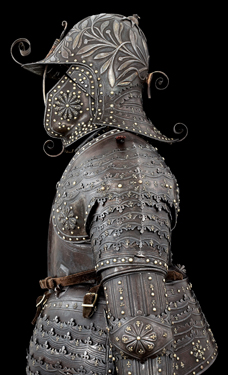
France, circa 16251630.
Paris, musée de l’Armée. 1014 I / G 123 -
Armour of Cardinal de Richelieu
2/7 The excessive weight of this armour (47.7 kg) ensures maximum protection to its wearer. The monogram combining the letters P of A and R, engraved in several places, can be attributed to Armand du Plessis, Cardinal de Richelieu, while marine emblems such as the trident of Neptune serves as a reminder that Cardinal de Richelieu had held the prized office of grand maître, chef et surintendant général de la navigation et commerce de France (Grand Master of the Navy and Trade). It is likely that the CardinalMinister inspected the facilities of the Armée Royale during the Great Siege of La Rochelle dressed in this armour or a similar piece. 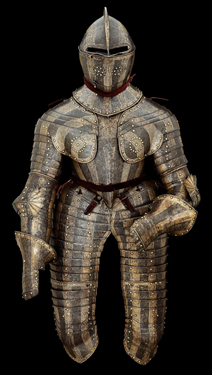
France, circa 1625-1630
Paris, musée de l’Armée. G 105 -
Dual matchlock-flintlock gun
3/7 
Francis Duclos (dates unknown), Paris, 1636.
Paris, Musée de l'Armée. 998 I / M 410 -
Matchlock musket bearing the coat of arms and emblems of Cardinal de Richelieu
4/7 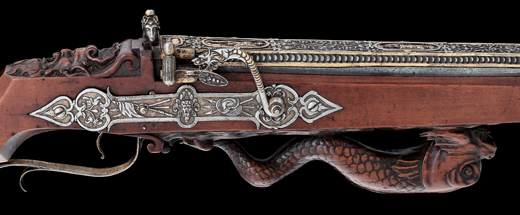
Holland, circa 1630.
Paris, musée de l’Armée. M 37The dolphin and Neptune engraved on this musket along with the coat of arms engraved on the butt plate are a reminder that Cardinal Richelieu had held the office of grand maître, chef et surintendant général de la navigation et commerce de France (Grand Master of the Navy and Trade) since 1627. -
Louis XIII Crowned by Victory
5/7 On August 7, 1620, the nobles who were backing up Marie de Medicis to regain her old power lost against the troops led by her own son only aged 18 at the PontsdeCé, in the vicinity of Angers. It is likely that this famous painting was painted to celebrate this military exploit. 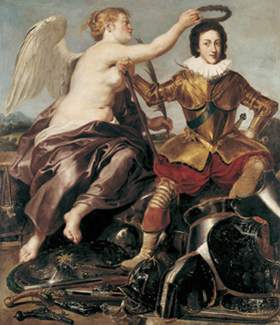
Workshop of Peter Paul Rubens.
Oil on canvas, circa 1620.
Leeds, the Board of Trustees of the Royal Armouries
Inv.: I. 41 -
Triple Portrait of Cardinal de Richelieu
6/7 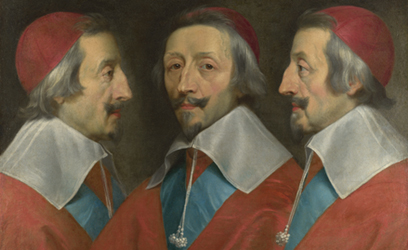
Philippe de Champaigne (1602-1674).
Oil on canvas, 1642.
London, National Gallery (NG 798)This painting was executed in Paris, and sent to Rome as a model for the making of a bust of Richelieu by the sculptor Gian Lorenzo Bernini, which is presently kept at the Musée du Louvre. -
Cardinal Richelieu at the siege of La Rochelle
7/7 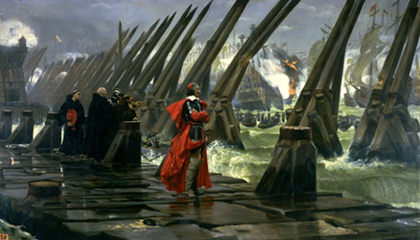
Henri-Paul Motte (1846 – 1922).
Oil on canvas, 1881.
La Rochelle, musées d’Art et d’Histoire (MAH.1886.1.3)Pierre Henri Motte was a pupil of JeanLéon Gérôme. He is best known for his painting depicting Cardinal de Richelieu standing on the largest seawall built to block the seaward access to La Rochelle in order to observe the movements of the Royal Navy. This work of art which possesses a form of cinematic efficiency has become the most iconic image of the Great Siege of La Rochelle and probably of the Cardinal himself.




